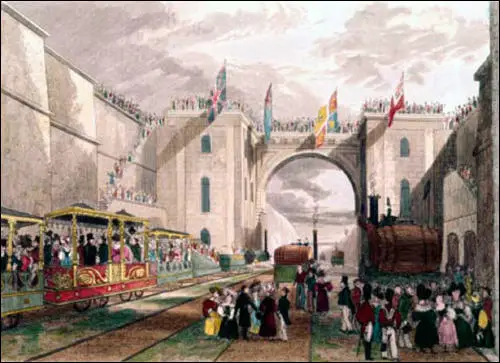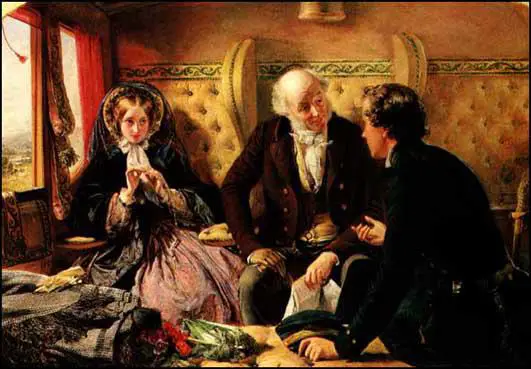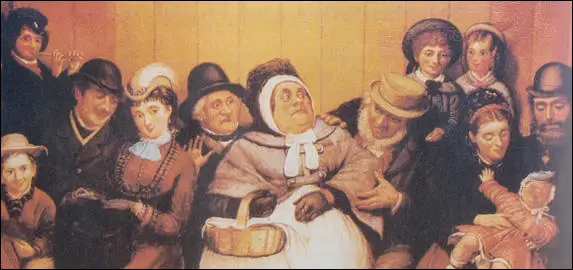Railway Mania
Before the establishment of the railway industry, most trading companies were owned by individuals, families or partnerships. However, vast sums were needed to build railways. One way that a railway company could raise this money was to form a joint stock company. For example, the Liverpool and Manchester Railroad Company calculated they would need over £400,000 (600 million in today's money) to build their railway. They obtained this money by persuading 308 people to buy 4,233 shares (at £100 a share) in the company.
In 1824 the company published its prospectous: "The total quantity of goods passing between Liverpool and Manchester is estimated to be 1,000 tons per day... The average length of time taken (by canal) is 36 hours... The average charge... has been 15s a ton ... By the projected railroad, the transit of goods between Liverpool and Manchester will be 4 or 5 hours, and the charge to the merchant reduced by at least one-third." (1)
The Quarterly Review supported the building of the Liverpool & Manchester Railway but urged the government to limit the speed of the locomotives: "What can be more palpably absurd than the prospect held out of locomotives travelling twice as fast as stagecoaches! We trust that Parliament will, in all railways it may sanction, limit the speed to eight or nine miles an hour." (2)

Most of the early railway companies were very successful. Shares in the Stockton and Darlington railway that were purchased for £100 in 1821 could be sold for £260 in 1838. The Liverpool and Manchester Railway Company regularly paid out an annual dividend of £10 for every £100 invested. By 1837 over eighty railway companies had plans to add to the network. That year over a thousand miles of track were laid down. (3)
The railway system enabled manufacturers to transport their goods all over Britain. Farmers also benefited from the railways. Before the arrival of the railways, farmers could only sell perishable foodstuffs such as milk, butter and vegetables to local people. The railways made it possible to send food to the towns many miles away. (4)
The railways, by lowering transport costs, also helped the growth in the export trade. Manufacturers used the railway network to transport their goods to the ports. The railway network also increased the circulation of newspapers and by using the railways instead of mail coaches, the post office was able to dramatically reduce the cost of sending a letter.
Eventually the railway companies began to realise that they could make money by carrying passengers. The number of passengers carried increased from 5.5 million in 1838 to 30 million in 1845. One of the first railway excursions was run in 1841 from Sheffield to Derby with fares of 7s for first class, 5s for second class, and 4s for third class who travelled in open wagons. (5)
Hippolyte Taine, a visitor from France, pointed out that while he was in Scotland, "I came across a cheap excursion train, its carriages crammed with people. They were all on the way to a religious meeting... where a number of famous preachers would be speaking... My neighbour told me there would be twenty thousand people at the meeting, some of them coming fifty or sixty miles." (6)
At first, railway companies concentrated on transporting goods. However, it soon became clear that there was a large number of people who wanted to travel by rail. This is not surprising as trains were both quicker and cheaper than stage coaches. It was not long before railway companies were receiving more revenue from passengers than from carrying freight.
Passenger trains usually contained first, second and third-class carriages. First-class carriages were completely enclosed and had padded seats, arm rests, and glass windows. These carriages were also fitted with springs to ensure a comfortable ride. Charles Grenville described his first train journey in 1837: "Nothing can be more comfortable than the vehicle in which I was put, a sort of chariot with two places, and there is nothing disagreeable about it but the occasional whiffs of stinking air which it is impossible to exclude altogether. The first sensation is a slight degree of nervousness and a feeling of being run away with, but a sense of security soon supervenes and the velocity is delightful. Town after town, one park and chateau after another are left behind with the rapid variety of a moving panorama, and the continual bustle and animation of the changes and stoppages make the journey very entertaining." (7)

Second-class carriages had wooden benches and were open at the sides, while third-class carriages were just open trucks. One passenger complained: "We were put into a truck worse and more exposed than cattle trucks. There were seats, or forms to sit on, but they were swimming with rain." Louis Milroy Hayes described a journey he took in Manchester in 1840: "In these third-class carriages there was a general feeling of bare boards and cheerlessness as you entered them and if you were travelling in the winter time they gave you a kind of cold shiver... The seats were cushionless and the longer you sat on them the harder they seemed." (8)

These high profits encouraged the formation of other railway companies. This rapid expansion of railways gave a tremendous boost to the iron and coal industries. It was also estimated that by the 1830s the railway companies were using over 200 million bricks a year. By 1855, over £300 million had been invested in British railway companies and 8,000 miles (12,800 kilometres) of track had been built. By 1860, the basic network of British railways was complete. (9)
George Hudson, the Conservative MP for Sunderland became known as the Railway King. After buying a controlling interest in the North Midland Railway, he established the Great North of England Company so that they could complete the line from York to Newcastle-upon-Tyne. To obtain permission from the House of Commons, Hudson distributed over £3,000 in bribes. Hudson followed this by forming the Midland Railway Company. He now raised the sum of £5,000,000 to link the Midlands with Scotland. To persuade people to invest in the company he personally guaranteed the payment of a 6 per cent dividend.
By 1844, Hudson's companies now controlled 1,016 miles of railway track. A survey in 1845 revealed that Hudson had £319,835 invested in railway shares. Hudson continued to buy shares in railway companies. He purchased a controlling interest in the Newcastle & North Shields Railway and the Great North of England Railway. It was later revealed that some of his share-dealings were not being entered in the company's account books. (10)
George Hudson also began using inside information to manipulate share prices. In the short-term this made Hudson and his friends a great deal of money. However, railway shares were now over-priced and towards the end of 1847, their value began to fall dramatically. People who had heavily invested in railway shares faced financial ruin. A great deal of hostility was turned on the man who had persuaded them to buy shares and Hudson was forced to resign as chairman of all the railway companies under his control. (11)
A committee of investigation was formed to look into Hudson's railway companies and it soon became clear that in the past he had not told potential buyers of shares, the truth about the real financial state of his companies. The investigators also discovered that Hudson had been paying bribes to MPs. Hudson had also sold shares he owned to the Great North Railway at inflated prices and had sold land to Newcastle & Berwick Railway that he did not own. George Hudson admitted these offences and agreed to pay back the money he had swindled from the shareholders. However, he did not pay back the money he owed to shareholders and in July 1865, was imprisoned in York Castle for debt. (12)
Primary Sources
(1) Liverpool and Manchester Railroad Company Prospectus (1824)
It is upon the same principle that railroads are now proposed to be established; as a means of conveyance manifestly superior to existing modes: possessing, moreover, this recommendation, in addition to what could have been claimed in favour of canals, namely, that the railroad scheme holds out to the public not only a cheaper, but far more expeditious conveyance than any yet established....
In deciding upon the proposed route, the committee have been anxious, at considerable inconvenience and expense, to select a line which may not only be eligible.... but may be as little objectionable as possible, with reference to individual and local interest.
The ground has been surveyed by eminent engineers, and the estimated expense of a railroad, upon the most improved construction, including the charge for locomotive engines to be employed on the line, and other contingencies, is £400,000 - which sum it is proposed to raise in 4,000 shares of £100 each.
The total quantity of merchandise passing between Liverpool and Manchester is estimated, by the lowest computation, at 1,000 tons per day. The bulk of this merchandise is transported either by the Duke of Bridgewater's Canal, or the Mersey and Irwell Navigation. By both of these conveyances goods must pass up the river Mersey, a distance of 16 or 18 miles, subject to serious delays from contrary winds, and not unfrequently, to actual loss or damage from tempestuous weather. The average length of passage, by these conveyances, including the customary detention on the wharfs, may be taken at 36 hours.... The average charge upon merchandise for the last 14 years has been about 15s. per ton.
By the projected railroad, the transit of merchandise between Liverpool and Manchester will be effected in four or five hours, and the charge to the merchant will be reduced at least one-third. Here, then, will be accomplished an immense pecuniary saving to the public, over and above what is perhaps still more important, the economyy of time.... It will afford a stimulus to the productive industry of the country; it will give a new impulse to the powers of accumulation, the value and importance of which can be fully understood only by those who are aware how seriously commerce may be impeded by petty restrictions, and how commercial enterprise is encouraged and promoted by an adherence to the principles of fair competition and free trade.
(2) Thomas Wood describing a train journey in 1845.
I took a train to Rochdale... We were put into a truck worse and more exposed than cattle trucks. There were seats, or forms to sit on, but they were swimming with rain.
(3) Charles Grenville, diary entry (18th July, 1837)
Tired of doing nothing in London, and of hearing about the Queen, and the elections, I resolved to vary the scene and run down here to see the Birmingham railroad.... So I started at five o'clock on Sunday evening, got to Birmingham at half-past five on Monday morning, and got upon the railroad at half-past seven. Nothing can be more comfortable than the vehicle in which I was put, a sort of chariot with two places, and there is nothing disagreeable about it but the occasional whiffs of stinking air which it is impossible to exclude altogether. The first sensation is a slight degree of nervousness and a feeling of being run away with, but a sense of security soon supervenes and the velocity is delightful. Town after town, one park and chateau after another are left behind with the rapid variety of a moving panorama, and the continual bustle and animation of the changes and stoppages make the journey very entertaining
The train was very long, and heads were continually popping our of several carriages, attracted by well-known voices, and then came the greetings and exclamations of surprise, the 'Where are you going?" and How on earth came you here?" Considering the novelty of its establishment, there is very little embarrassment, and it certainly renders all other travelling irksome and tedious by comparison. It was peculiarly gay at this time, because there was so much going on. There were all sorts of people going to Liverpool races, barristers to the assizes, and candidates to their several elections.
(4) In 1842, Samuel Laing wrote a report on railway carriages.
The sides and ends of the carriages are only two feet high... a moderate shock is enough to throw the passengers out,of the carriage.
(5) The Scotsman newspaper (1825)
When the locomotive is brought fully into use... I expect to see the present rate of travelling by stage-coach doubled... Commodities, inventions, discoveries, opinions will circulate with a rapidity hitherto unknown.
(6) Hippolyte Taine, Notes on England (1865) page 362
Between Keith and Aberdeen I came across a cheap excursion train, its carriages crammed with people. They were all on the way to a religious meeting... where a number of famous preachers would be speaking... My neighbour told me there would be twenty thousand people at the meeting, some of them coming fifty or sixty miles.
(7) John Bull Magazine (1835)
We denounce the railway mania as destructive to our country... huge mounds are to intersect out beautiful valleys; the noise and stench of locomotive steam-engines are to disturb the quiet of the countryside.
(8) Autobiography of a Navvy, Macmillan's Magazine (1861)
I started on the road 'tramping' about the country, looking for work... I would wander on till I could find a gang at work on some railroad or large building. Once I travelled about for three days without having anything to eat... I found work at Rochester... I worked in a tunnel for three months. It is rather chokey kind of work, all done by candle-light, and the smoke makes the air thick and misty. Once, when I was in Dorsetshire, I was in a tunnel that fell in both ends... It made me feel very bad when my favourite sister was very ill and wanted to see me. My brother Benjamin at last found me... but I could not go home, for I'd been drinking and pawning my clothes, and I was ashamed to go and see them all... My sister died... although she was much younger than I was.
(9) F. S. Williams, Our Iron Roads (1852)
The increasing requirements of railway construction... drew great numbers of men, by the attraction of high wages, from all parts of the country... Many a sturdy labourer, who had involved himself in debt in his native village, or had committed some petty breach of the peace, sought refuge and employment on the railways.
Student Activities
Child Labour Simulation (Teacher Notes)
Road Transport and the Industrial Revolution (Answer Commentary)
Richard Arkwright and the Factory System (Answer Commentary)
Robert Owen and New Lanark (Answer Commentary)
James Watt and Steam Power (Answer Commentary)
The Domestic System (Answer Commentary)
The Luddites: 1775-1825 (Answer Commentary)

